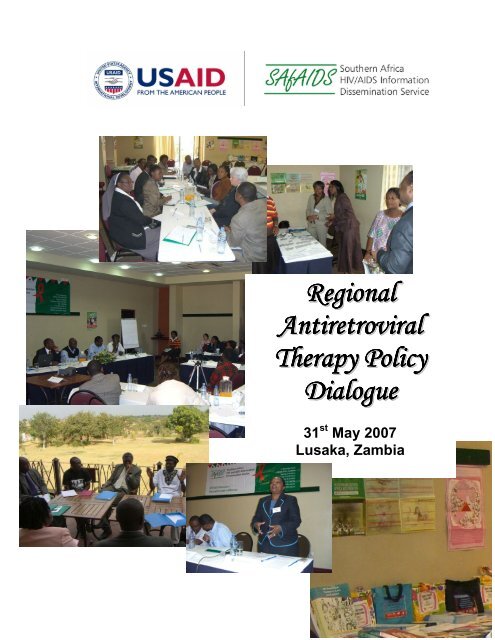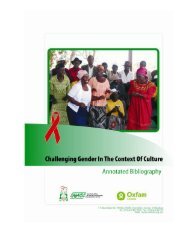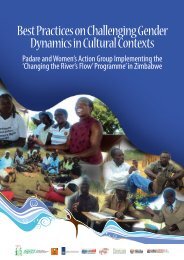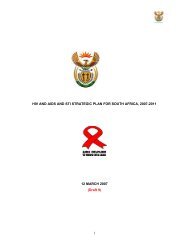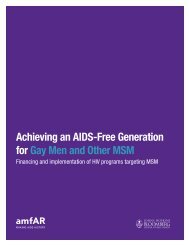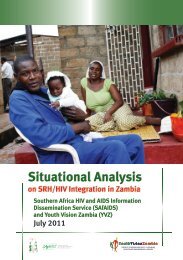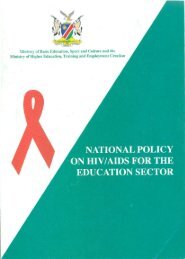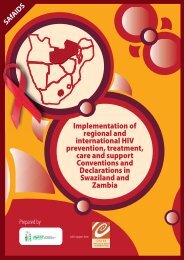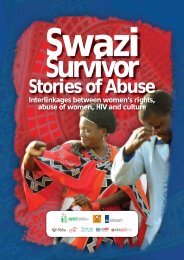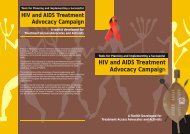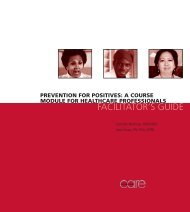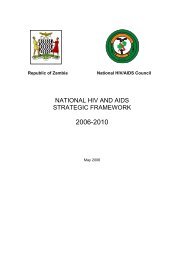Regional ART Policy Dialogue Report.pdf - SAfAIDS
Regional ART Policy Dialogue Report.pdf - SAfAIDS
Regional ART Policy Dialogue Report.pdf - SAfAIDS
Create successful ePaper yourself
Turn your PDF publications into a flip-book with our unique Google optimized e-Paper software.
<strong>Regional</strong>AntiretroviralTherapy <strong>Policy</strong><strong>Dialogue</strong>31 st May 2007Lusaka, Zambia
FOR:<strong>SAfAIDS</strong> Program “Strengthening Community Capacitiesin Prevention, Care, Support and Treatment of HIV and AIDSComplementing National Efforts”BY:Southern Africa HIV and AIDS Information DisseminationService (<strong>SAfAIDS</strong>)17 Beveridge Road, Avondale, HarareP.O. Box A509 Avondale, HarareZimbabweTel: +263 4 336193/4Fax: +263 4 336195Email: info@safaids.org.zwWebsite:www.safaids.org.zwDATE: June 20072
TABLE OF CONTENTSContentAcknowledgementsPage………………………………………………….4Acronyms………………………………………………………………….51. Introduction ………………………………………….61.1 Background 61.2 Purpose of <strong>Regional</strong> APD 71.3 Direction of <strong>Regional</strong> APD 72. In Context ………………………………………………….82.1 Participants Profile ………………………………….82.2 Setting the Pace ………..………………….82.3 Keynote Address ………………….102.4 <strong>Dialogue</strong> Program Overview ………………………………..103. Presentation Overviews ………………………………….113.1 <strong>Regional</strong> Voice of People Living With HIV and AIDS ….11(PLHIV): How does MIPA scale-up fit in to the <strong>ART</strong>Agenda?3.2 A <strong>Regional</strong> Approach: Civil Society’s Case ……………….123.3 Public Health Enhancement and <strong>Regional</strong> <strong>ART</strong>Sustainability………………….123.4 <strong>Regional</strong> Trade and Universal Access: How do <strong>Regional</strong>Trade issues engage with <strong>ART</strong> sustainability? ........…….143.5 <strong>Regional</strong> Manufacturing and Procurementof ARVs: Possibilities, Challenges and the Next Step. …..154. Discussion Highlights …………………………………..…..….175. The Way Forward ………………………………………………….18Annexure 20Annex I: RAPD program 20Annex II: RAPD Participants Details 223
ACKNOWLEDGEMENTSSincere gratitude is extended to all colleagues who made the <strong>Regional</strong> <strong>ART</strong> <strong>Policy</strong><strong>Dialogue</strong> (RAPD) a success. We recognise and appreciate all participating regionalorganizations and groups from across the southern African region, for theiroverwhelming support and valuable input to the RAPD proceedings.<strong>SAfAIDS</strong> deeply appreciates the unwavering support received from the Government ofZambia, through the presence of their esteemed officials from the Ministry of Healthand National AIDS Council. <strong>SAfAIDS</strong> anticipates that they will take into cognisancepoints raised during the RAPD to inform decision-making at national and regionallevel, and subsequently promote the agenda of making regional <strong>ART</strong> programmingsustainable across all Southern Africa countries.We thank the <strong>SAfAIDS</strong> country implementing partners in both Swaziland and Lesotho,who participated in this event and shared their valuable contributions, thus bringing tothe fore critical community perspectives that made the dialogue a platform formeaningful self-review and strategy formation. The participation of representatives ofgroups of people living with HIV and AIDS, and stakeholders from civil society, theprivate sector, multi- and bi-lateral organisations is keenly acknowledged. Our hoperemains that all recommendations were raised in this dialogue will be considered, andcontribute towards policy review and development within scaling-up of access toprevention, care, support and treatment (Universal Access) across the region.<strong>SAfAIDS</strong> acknowledges with sincere appreciation the support of USAID (RHAP), forthe generous funding availed by the United States Government, without whosesupport this event could not have been realised.<strong>SAfAIDS</strong>June 20074
ACRONYMSACPARV<strong>ART</strong>EPA(s)MIPAPATAMPLHIVPEPFARRAPDRHAPSADC<strong>SAfAIDS</strong>USGWHOWTOAfrican, Caribbean and the PacificAntiretroviral (Drugs)Anti Retroviral TherapyEconomic Partnership Agreement(s)Meaningful Involvement of People Infected or Affected by HIV/AIDSPan-African Treatment Access MovementPeople Living With HIVPresident’s Emergency Plan for AIDS Relief<strong>Regional</strong> Antiretroviral Therapy <strong>Policy</strong> <strong>Dialogue</strong><strong>Regional</strong> HIV and AIDS ProgramSouthern Africa Development CommunitySouthern Africa HIV and AIDS Information Dissemination ServiceUnited States GovernmentWorld Health OrganisationWorld Trade Organization5
1. INTRODUCTION1.1 BackgroundSustained access to anti-retroviral therapy (<strong>ART</strong>) remains a fundamental and indispensablecomplement to both treatment and prevention of HIV, as it restores hope to communities andsocietal structures. The treatment for HIV and AIDS has reached an “emergency” state acrossthe southern African region. While governments and policy making bodies within the regionhave engaged in meaningful deliberations and offered commitment towards upholding thisneglected human right – the Right to Treatment, the future of existing <strong>ART</strong> mechanisms andstructures, and their effectiveness in the region, continue to be at risk of collapse.Delaying the standardization of anti-retroviral treatment modalities across the region can onlyserve to undermine public health systems. As treatment literacy and community preparednessscales-up, access to HIV testing and counselling service increases, and access to treatment isincreasingly savoured within southern African countries, the dangers and complexitiesrevolving around ‘drug anarchy'; inappropriate drug manufacturing, trading, prescribing anduse; inaccessibility of treatment, referral and follow-up services to mobile populations (refuges,cross-border traders, migrants and so forth); food and livelihoods insecurity, may brim overuncontrollably.This clearly demands urgent measures that pivot around a united southern African <strong>ART</strong> <strong>Policy</strong>“voice”. A voice that is fuelled by each governments’ commitment, and driven by a <strong>Regional</strong><strong>ART</strong> Sustainability Strategy. Until the reigns of <strong>ART</strong> dynamics are fully controlled by thehands of southern African policy makers, and complementing partners, any gains made inachieving MDGs, Scale-up of Universal Access and Global Fund targets, will continue to bereversed and jeopardise the interests of millions of lives across this rich region.Creating a unified southern African paradigm shift towards a SADC endorsed regional <strong>ART</strong>stance that supports citizens of southern African, irrespective of socio-politico-legal status,access to <strong>ART</strong> services, IS a possibility. This has been demonstrated worldwide, includingother developing regions such as Latin America and East Asia. Hence in light of the wealth ofknowledge, community-based resources and commitment of southern African policy makers,leaders, and implementers, the establishment if an operational <strong>Regional</strong> <strong>ART</strong> SustainabilityStrategy that promotes and protects the basic right to the continuum of HIV/AIDS treatment ofpopulations in the southern African region, can become a reality.Figure 1: Participants at the RAPD6
1.2 Purpose of the <strong>Regional</strong> APDThe Southern Africa <strong>Regional</strong> Antiretroviral <strong>Policy</strong> <strong>Dialogue</strong> (APD) served as a platform foropen, frank and meaningful experience sharing, reflection and strategizing within the <strong>Regional</strong>treatment forte of HIV/AIDS <strong>Policy</strong> making. It contributed towards closing informationexchange gaps around <strong>ART</strong> issues, and availing crucial opportunities for bridging theinformation gaps between governance/policy making levels with community implementers’“voices”.<strong>SAfAIDS</strong> hosted this engaging forum to allow key stakeholders to deliberate on progress,challenges, barriers and opportunities relating to <strong>ART</strong> policy and practice in the region. TheRAPD facilitated multi-disciplinary and collective identification of effective strategies forimproved regional programming and policy-making. The <strong>Regional</strong> <strong>ART</strong> <strong>Policy</strong> <strong>Dialogue</strong> servedas an avenue for strengthening partnerships and collaborations between southern AfricanGovernments and other key regional actors, towards harmonised and concerted HIV/AIDSTreatment related <strong>Policy</strong> Making and Programming.1.3 Direction of the <strong>Regional</strong> APDThe key thrust of the APD is ‘dialogue’. <strong>ART</strong> <strong>Policy</strong> <strong>Dialogue</strong>s are not anticipated to apportionblame and antagonize, but rather to foster a culture of cooperation, self-review, self-critic andownership of the agenda at hand. This event drew representatives from regionalorganisations of People Living with HIV (PLHIV), southern African governments, regionalpolicy-making bodies, civil society and private sector representatives, as well as bi- and multilateralagencies in the region.The APD was centred around a theme that is based on a regionally relevant and specific <strong>ART</strong>related policy question. It is around this theme that sharing of efforts made, experiences,challenges, successes and lessons learnt took place. The <strong>Regional</strong> <strong>Dialogue</strong> created leveragefor wider advocacy efforts, and rights-based programming within the HIV/AIDS treatmentscope, as countries seek to meet their Universal Access targets and scale-up access totreatment for their citizens.The promotion of Meaningful Involvement of People Infected or Affected by HIV/AIDS (MIPA)– from ideal concept to urgent - remains foremost to the conceptualisation and realisation ofthis event.Figure 2: Antiretroviral Therapy Literacy and TrainingMaterials on display at the RADP7
2. IN CONTEXTThis report seeks to summarise the proceedings of, and share outcomes from, the <strong>Regional</strong><strong>ART</strong> <strong>Policy</strong> <strong>Dialogue</strong> (APD) that was held at the Cresta Golfview Hotel in Lusaka Zambia onthe 31 st May, 2007. The theme was “Sustainability of <strong>ART</strong> Programs in Southern Africa-Isa <strong>Regional</strong> Approach the Answer?. See program in Annex I. The <strong>Regional</strong> <strong>ART</strong> <strong>Policy</strong><strong>Dialogue</strong> drew over 50 participants from 8 southern African countries (more than halfparticipants were from outside Zambia), representing PLHIV organisations, NACs, donorcommunity, media houses from Zambia, USG Partners, CBOs, pharmaceutical companies,legal practitioners, <strong>Regional</strong> NGOs, <strong>SAfAIDS</strong> Board of Trustees and program implementingpartners. This report is complemented by a DVD, that documented the RAPD proceedings.Rouzeh Eghtessadi (<strong>SAfAIDS</strong> Program Manager) welcomed participants to the RAPD. Sheacknowledged the support from USAID and the Ministry of Health and Social Welfare and theNational AIDS Council of Zambia, and extended appreciation to other donors and partnerspresent. Following the welcome, Ms. Eghtessadi gave an overview of the purpose and themeof the RAPD, and reinforced that this event was apioneering event which to sought to take a positivedirection in terms of extrapolating deliberations that areself-analytical, reflective and progressive. She furtheremphasized that the RAPD seeks to engage keystakeholders that include the civil society organizations,PLHIV, the governments, private sector and donors, onthe progress, challenges and barriers and opportunitieswith respect to national <strong>ART</strong> programs and explore howthey coagulate in a regional approach. Ms. Eghtessadiencouraged participants to utilise the RAPD platform inidentification of effective strategies for improved access,availability and sustainability of <strong>ART</strong> roll-out at nationaland regional levels, within a multidisciplinary context.Figure 3: Ms. Eghtessadi (<strong>SAfAIDS</strong>)Sharing an overview of the RAPD2.1 Participants ProfileA total of 52 participants were present at the RAPD, and were drawn from 8 southern Africancountries (Botswana, Lesotho, Mozambique, Namibia, South Africa, Swaziland, Zambia andZimbabwe). They represented PLHIV groups, NACs (from Lesotho, Swaziland and Zambia),the donor community (SIDA, HIVOS), media houses from Zambia, USG Partners, CBOs,pharmaceutical companies, legal practitioners, <strong>Regional</strong> NGOs (SATAMO, SAT andSANASO), and program implementing partners. See Annex II for participant’s details. VariousZambian media houses were present to document the RAPD.2.2 Setting The PaceLois Chingandu, the <strong>SAfAIDS</strong> Executive Director, officially opened the dialogue session and inher opening remarks welcomed all the stakeholders at the dialogue session. She briefed theparticipants on the background to the <strong>Regional</strong> <strong>Policy</strong> dialogue; stating how <strong>SAfAIDS</strong> hadpioneered <strong>Policy</strong> <strong>Dialogue</strong>s in Zambia, interrogating country policies that existed aroundtreatment access. She stated that owing to the successes and the notable impact of thedialogues in Zambia, <strong>SAfAIDS</strong> decided to extend them to Swaziland and Lesotho were the<strong>Policy</strong> dialogue have also been a huge success, under a USAID funded program in bothKingdoms.8
The success of the <strong>Policy</strong> <strong>Dialogue</strong>s at national level prompted <strong>SAfAIDS</strong> to take the <strong>Policy</strong><strong>Dialogue</strong> to regional level and address the issues of Access to Treatment as a regional issuerather than as country specific issues. Lois Chingandu shared that the dialogue series aimedto pioneer increased dialogue and shared radical thinking among stakeholders.Figure 4: Mrs. Lois Chingandu (Executive Director, <strong>SAfAIDS</strong>),during her opening remarksWith reference to the Abuja 2001 15% benchmark, the2005 African Union Assessment, the WHO 3 by 5initiative, she highlighted how much progress theSADC member states had achieved in the fightagainst HIV and AIDS, Tuberculosis and Malaria, andnoted that as a result of these, many policies,frameworks and mechanisms were now in place.Member states where allocating a significantpercentage of their national expenditure to health, witha few countries now manufacturing ARVs and otherson the way to establishing their own industries. Shefurther stated that despite these notable successesthere were still some fundamental challenges beingfaced, some of which are lack of resources toeffectively fight HIV and AIDS - despite manycountries in Africa receiving support from the GlobalFund (GF), PEPFAR and other bilateral andmultilateral agencies as it is far short of the levelsrequired to achieve Universal Access.Mrs. Chingandu raised concerns around there is a urgent need to interrogate “ a regionalapproach the way forward”. She indicated that from a historical perspective Africa is one hugecontinent simply divided by man-made boundaries, boundaries that failed to take note of theexisting cultural groups, creating borders that are unnatural to the African way of life. HIV andAIDS have crossed these borders, killing more people than any other disease in the history ofmankind, in general and Africa to be specific. She went on to define sustainability as being selfreliant, pointing to taking responsibility for ones own future.She pointed out that although the African Union acknowledges the importance of integration,harmonization and regional unity there has been no serious commitment among membercountries to support the cause as evident in the slow pace at which this is happening. Thecurrent trends in HIV and AIDS are slowly revealing that individual approaches alone do notwork. Lastly, she emphasized the need for regional integration and collaboration in the fightagainst HIV and AIDS. She urged SADC member states to come together to design a jointtechnical plan on how to respond to HIV and AIDS, to address key issues of access toessential medicines, <strong>ART</strong>, regional issues of; human resources, resource mobilization andhealth systems. She emphasized the urgency of a regional policy on <strong>ART</strong> to facilitate theissues of drug manufacturing, procurement and distribution for the region while alsoaddressing the issues of cross-border trading and movement.9
2.3 Keynote AddressDr. Mukonka the Director Public Health and Research in the Ministry of Health in Zambiaextended a warm welcome to participants, to Zambia. He acknowledged <strong>SAfAIDS</strong> and itscommitment to providing key stakeholders and the Zambian Government with a platform toengage in dialogue on the treatment access. He further pointed out that there were manylessons that other countries in the region could learn from Zambia. HIV and AIDS are equally ahuge challenge in Zambia, as in all the othercountries in sub-Saharan Africa, and theepidemic has now become high priority under thecountry’s Public Health Program.Dr. Mukonka indicated that Zambia was making ahead way in prevention, care and treatment ofHIV and AIDS and gave a brief account on theprogress in scaling up of access and treatment.He however, acknowledged some of thechallenges that the Ministry was facing and healluded to the fact that paediatric <strong>ART</strong> programsstill required additional concentrated efforts, asthe larger concentration of efforts is targeted atadult <strong>ART</strong>. The Ministry of Health is placingenhanced efforts in scaling up of paediatric <strong>ART</strong>.This move by the Ministry, Dr Mukonka stated,should also prompt the involvement of the privatesector so as to complement the efforts of theMinistry, donors and civil society organizations.Figure 5: Dr.Mukonka (Ministry of Health, Zambia),offering Keynote Address at the RAPD, as part ofthe Official Opening. Mr. Tapiwa Kujinga (SATAMO)sitting on left.He drew attention to the human resources crisis that Zambia was facing. “Some of us who arerunning projects have realized that Zambia will not attain the MDGs unless we begin to investheavily in human resources” he said. As the demand for health services continues to rise, thenumber of health workers in Zambia has been decreasing. Retention of health workers hasbecome a major challenge as government had failed to offer competitive conditions of service.He further shared that as a Ministry they were not only faced with the challenge of reducednumbers in human resources but also competences and distribution problems. This he statedis clearly seen in the way most health workers prefer urban health centres to those in the ruralareas. And is a challenge extended to other countries across the southern African region, andone which the RAPD would undoubtedly debate around.2.4 <strong>Dialogue</strong> Program OverviewFollowing the official keynote address made by Dr Mukonka, a series of triggeringpresentations were made from the representatives of civil society organizations, PLHIVgroups, pharmaceuticals and public health, highlighted diverse aspects relating to the theme ofdebate. Attention was drawn towards the PLHIV concerns in the region and their standpoint onthe sustainability of <strong>ART</strong> programs in Southern Africa. The public health systems perspectiveraised a number of concerns around the sustainability of <strong>ART</strong> programs in the SADC region,which included, but were not limited to, affordability of ARV drugs and other therapycomponents, and the prevailing heavy reliance on donor funding.10
3. PRESENTATION OVERVIEWS3.1 <strong>Regional</strong> Voice of People Living With HIV and AIDS (PLHIV): How does MIPAscale-up fit in to the <strong>ART</strong> agenda?Ms. Thembi Nkambule National Coordinator of Swaziland National Network of People Livingwith HIV/AIDS (SWANNEPHA) drew attention to the concerns of PLHIV in the region – a keyconcern being donor dependency. She pointed out that PLHIV groups do not see the provisionof ARVs in the region as a life-time program that recognizes that we have to receive the ARVsfor life. She pointed out that the <strong>ART</strong> programs in the region are seen as projects in whicheach donor has to fulfil their obligation to provide treatment to African countries. She posed aserious question “ Will our governments, especially in the SADC region, continue to roll-out<strong>ART</strong> programmes after the donors leave, especially are some governments are not allocatinghuge resources towards current <strong>ART</strong> programmes?”. Ms. Nkambule also stated that mostdonor programmes are running on what could be termed a ‘donor requirement’ which in mostcases does not take into account the countryspecific requirements. She shared thattreatment in the region was parallel to thehealth systems in individual countries. Drawingattention to natural disasters, such as droughts,her concern was whether governments hadsustainable plans for addressing HIV and theimpact of drought, and how lack of nutritionwould influence the gaols of <strong>ART</strong> scale-up. Themisaligned allocation of funds by governmentsto drought impact alleviation versus HIV,suggests that governments probably viewdroughts as a short-term problem and HIV andAIDS as a long-term problem. This needs to beaddressed urgently.Figure 6: Thembi Nkambule (SWANNEPHA,Swaziland) shares the regional PLHIV perspectivesMs Nkambule went further to express her concern on the lack of harmonized protocols orguidelines in the SADC region and pointed out that if she left her home country as a PLHIVshe would not receive the same treatment in another SADC country. She called for morefunding for treatment literacy especially for countries with little or no resources: “We need aregional approach to treatment literacy, so countries that have done a lot in treatment literacywill assist those countries who are struggling to implement their own.” Meanwhile issues ofhuman resources shortages remain inadequately and ineffectively addressed. To this effectshe went on to point out “ the ineffectiveness of the SADC HIV and AIDS Unit”. Ms Nkambulefelt that the unit would be useful in the area of government procurement, guidelines andprotocols especially monitoring and evaluating government’s commitment, and raised thefollowing critical issues for consideration:• Lack of harmonized protocols and guidelines within the SADC region• Slow implementation of government programs and commitments to universal access• Huge donor dependency in treatment programs• Poor or no consideration of country requirements by donor agencies• Myopia of the region on the length of <strong>ART</strong> programs• Treatment in the region is parallel to health systems11
Lastly, Ms Nkambule brought to the fore some recommendations:• sustainability of <strong>ART</strong> programs by governments in Southern Africa needs toaddressed in earnest, “yesterday not tomorrow” by SADC• the SADC HIV/AIDS Unit needs to begin to advocate for the procurement of ARVdrugs in a standardized manner accessible across the whole SADC region• governments need to adhere to their monitor and evaluate commitments3.2 A <strong>Regional</strong> Approach: Civil Society’s CaseMr Cesar Mufanequico from Pan African Treatment Access Movement (PATAM) began hispresentation by making specific reference to the Abuja 2006 conference where African Headsof State committed themselves to accelerating Prevention, Treatment Care and Support. Hefurther raised some of the concerns that civil society organizations have regardingsustainability of <strong>ART</strong> programs in Southern Africa. In light of the next African Union Summitthat was to be held in Ghana, Mr Mufanequico posed the question as to “ what will countries(particularly in the SADC region) will be reviewing?”, as they all seem to still be in the planningstage, in as far as the commitments they had made at the Abuja Conference, with little actionhaving been taken towards consolidating the regional <strong>ART</strong> context. He noted that it is probablynot the lack of resources that is a hindering factor to consolidating the regional <strong>ART</strong> agenda,but rather the lack of universal commitmentby governments in the region. .Figure 7: Mr Cesar Mufanequico (PATAM) presentsthe Civil Society standpoint to the RADP themeHaving raised these concerns,Mr Mufanequico then went on to makerecommendations: governments in theregion should domesticate the commitmentsthat are made at the regional andinternational summits so that they can easilybe monitored and evaluated. Civil societyorganizations will then want to be part of themonitoring and evaluation process to ensurecommitments made are followed up, and willexert all efforts in supporting governments inthee endevours.3.3 Public Health Enhancement and <strong>Regional</strong> <strong>ART</strong> SustainabilityHonorable Blessing Chebundo, representing the Africa Public Health Rights Alliance [APHRA]and the “15% Now!” Campaign, began his presentation by highlighting that since its launch onDecember 10, 2006, APHRA [and the 15% NOW campaign) was the first to articulate PublicHealth for Africa as a ‘Rights and Development Issue across Africa' and beyond. APHRAtherefore brings together actors from various key sectors of health in the civil societyorganizations, including those working in the field of <strong>ART</strong>. Hon Blessing Chebundo brought tothe fore <strong>ART</strong> relevant issues of concern within the Public Health sector. He pointed out thatthere is no clear or tangible <strong>Regional</strong> Strategic Plan for sustainability of HIV and AIDStreatment access in the SADC region. He emphasized the need for tariffs or rebates for12
local/regional producing companies, thus facilitating that the cost for essential medicines beaffordable, and cautioned the prevailing heavy reliance on donor funding to finance publichealth services in most countries of the region. He explained that this has implications onnational priority settings. Sustainability becomes a challenge as resources of external donorsare unpredictable and may cease flow at any given time. He reiterated that Universal accessto HIV and AIDS prevention; care, support and treatment must be supported with adequatesupply of commodities, including ARVs, as a public health right. There is need to collectivelyaddress a shared burden. This would then demand shared resource mobilization andproduction units, leading to collective HIV and AIDS treatment management in the region.Hon Blessing Chebundo posed a pertinent question to the RAPD “ can this sharedresponsibility be the answer and then guard against prescribed solutions for the Region”?,probably yes, as it will enable generating <strong>Regional</strong> Advocacy prescriptions for a unified visionby Global Forces, such as the World Trade Organisation (WTO) and World HealthOrganisation (WHO), in the <strong>ART</strong> arena.In his recommendations, Hon Blessing Chebundo pointed out that a collective regionalapproach to the sustainability of <strong>ART</strong> programmes is certainly the way to go, through a<strong>Regional</strong> <strong>ART</strong> Strategic Framework that addresses the different barriers presented by differentmember states’ background. He also noted that the world production of ARV drugs isconcentrated in only a few industrialized countries. He pointed out that SADC can take learngood practices from the Indian and Chinese experience. And pool this, together with existingknowledge, facilities and resources in this region, to develop regional facilities andpharmaceutical plants to help scaling up of HIV and AIDS treatment. He further outlined howthe promotion of transfer of technology, with the available expertise and primary production,can begin without waiting for strong linkages to be fosteredbetween the academia and industrial research. Alternatively,if manufacturers, currently in existence are unwilling totransfer technology; the SADC region could build on the localcompanies currently producing ARVs drugs. Also noted wasa regional approach for creation of a favourable social,political and economical environment that permitsachievement of goals. This would further address the issue ofweak infrastructure and weak enforcement of policieslegislation. Hon. Chebundo explained that Protocols onHealth are important economic facilitating factors andcontribute to improving access to medicines, and policiesmust addressissues that are ofconcern in thesustainability of<strong>ART</strong> programmes,such as tariffs.Figure 8. Honorable Blessing ChebundoFigure 9: Mrs. Harriet Kunene (TASC,Swaziland) and Honorable Chebundo13
3.4 <strong>Regional</strong> Trade and Universal Access: How do regional trade issues engage with<strong>ART</strong> sustainability?In his presentation Mr. Thomas Deve (MWENGO), shared that it has been three years sincecivil society organizations, social movements, and mass-membership organizations acrossAfrica, the Caribbean, the Pacific (ACP) and Europe adopted the campaign to STOP theEconomic Partnership Agreements (EPAs) as currently designed and being negotiatedbetween the European Union and ACP groups of countries. The campaign was adopted onthe grounds that in their current form, the EPAs are essentially Free Trade Agreementsbetween unequal parties: Europe, with its overwhelming economic and political power, and thefragile and dependent economies of the ACP countries. In addition, Mr Thomas Deve pointedout that the process of the negotiations was characterised as imbalanced and rushed, allowingthe EU to impose its interests and agenda, and dictate the momentum of the negotiations tosuit its own needs and purposes.Mr Deve raised a number of concerns onFree Trade Agreements, new regionalpolitical structures and a number of economicand social regional blocs in Africa. Mr Devepointed out that the Free Trade Agreementswith the EU carry many dangers for ACPeconomies and their prospects for self-reliantgrowth and diversification. He furtherexplained that it will not foster fair competitionand has implications for productive sectordevelopment, industrialization efforts anddiversification. The EPAs and regionalintegration, with specific reference to theSouthern Africa Development Community(SADC), has had negative implications onintegration, hampering initiatives on regionalapproaches to HIV and AIDS treatment.Figure 10: Thomas Deve, tackling the complexitiessurrounding <strong>ART</strong> and the world of TradeSADC, a major regional bloc in Africa, that has 14 member states, namely, Angola, Botswana,the Democratic Republic of Congo, Lesotho, Madagascar, Malawi, Mauritius, MozambiqueNamibia, South Africa, Swaziland, Tanzania, Zambia and Zimbabwe has been divided andsplit since the inception of negotiations for the so-called Economic Partnership Agreementswith the European Union under the Cotonou Agreement. On the issue of integration in theregion, Mr Deve stated that the EPA negotiations have bundled countries in Africa into newregional political structures, a development that separates them from the existing regionalintegration frameworks and hampers regionalization efforts. A number of countries now belongto multiple economic integration blocs, and under the EPA structures, most regions in Africahave further split and their members bundled into weak and loose trade negotiatingmachineries. Mr Deve further recapitulated on the concern of donor dependency that had beenraised in earlier presentations. He explained that Africa’s capacity to assert as primary, theright of its countries to pursue autonomously determined policies which promote thedevelopment of its economies, and fulfil the social and human rights and livelihood needs ofthe continent’s people has been severely curtailed. This was true because most countries in14
the region had no capacity to carry out HIV and AIDS programmes with little assistance fromdonors as donors finance the huge part of their budgets. The European Unions’ plan for theso-called Economic Partnership Agreements (EPAs) with countries in the region is having theeffect of splitting SADC into two groups and undermining the potential for our futurecoordinated regional programmes for mutual economic and social developmentMr Deve in his presentations brought up some recommendations on the issues of concern forconsideration. He stated that the health implications of the EPAs need to be explicitlyrecognised and health officials should be included in the negotiations to ensure issues onhealth are taken into consideration. Health impact assessments have to be carried out whererelevant, such as in any areas where service liberalization may impact on health. EU and ACPcountries need to ensure that the EPAs are fully compliant with all regional and internationalhealth protocols and conventions before they are concluded.3.5 <strong>Regional</strong> Manufacturing and Procurement of ARVs: Possibilities, Challengesand the Next Step.Mr. Tobias Dzangare (Varichem) began his presentation by stating that Varichem beganmanufacturing ARVs in 2001, and then applied for its license in 2002 for registration in theRepublic of South Africa, Malawi and Zambia, and its local compulsory license was granted.Mr. Dzangare however, noted that despite Varichem making great strides in thepharmaceutical industry regarding the manufacturing of ARV drugs, the pharmaceuticalcompany has continued to face the challenges.The period of product formulation is one of the challenges, as this will take one to two years.Mr Dzangare went further to state that besides the long periods, the materials for experimentalbio-studies were very expensive. After explaining the challenges relating to productformulation, Mr Dzangare pointed out that the local registration process takes half to one yearand the WHO pre-qualification takes up to one to two years. Besides the long period of theWHO pre-qualification, their standards are very expensive and would only be fit for marketslarger than the domestic markets. In this way, the domestic markets become too small forviability while pursuing WHO pre-qualification process. Lack of government support for thelocal industry coupled with lack of foreign exchange, Mr Dzangare stated, are some of thechallenges that have hampered progress in the manufacturing of ARVs in the region.Figure 11: From left to right – Mr. Dzanagare (Varichem), Mr. Chiro (Caps),and Hon. B. Chebundo15
At the workplace, Mr Dzangare raised the concern on loss of human resources through braindrain. He further noted the shrinking of the disposable income has contributed to the collapseof infrastructure and the failure to cater for the extra cost for automatic changeover generatorswere also some of the challenges. There has also been the application of double standards byWHO regarding production versus distribution. In the region, the private sector market is notlarge enough and so there is an attempt to move to South Africa were larger markets can befound. South Africa however, prefers single entities and Varichem which has registered 6generic ARV drugs but lacked voluntary licences makes it impossible to market the ARV drugsin South Africa. Mr Dzangare also stated that the disruptive and costly effects of changes intreatment regimens are other challenges that need to be addressed.Mr. Dzangare shared the following recommendations:- WHO support with financial resources especially with regard to bio-studies, withfinancial assistance being received: WHO pay half of the funding and the companypaying the other half- WHO and governments of the countries concerned, should lend support to industryefforts to manufacture locally by removing duties on materials and capital equipmentand extending tax breaks- Harmonization of registration of products in the region by the governments and WHO.- Catapulting of policy reform, where WHO empowers local regulatory authorities so thatlocal manufacturers can access global funds for the local supply of locally registeredARV drugs- A regional ARV drugs’ list be developedMr. Eric Chiro (Caps) raised various issues of concern on the possibilities of regionalmanufacturing of ARV drugs. He touched on the matter of harmonization of regional ARVdrugs and registration of manufacturing facilities, and pointed out that there is need to facilitatemechanisms that enable fast-tracking the registration of ARV drugs at national and regionallevels. In light of a regional approach to thesustainability of <strong>ART</strong> programmes in southernAfrica, proper management of resources such asforeign funding at a regional level is imperative.Mr Chiro also pointed out that lower tariff regimeon the ARV drugs’ raw materials should beapplied. He shared some challenges to regionalmanufacturing of ARV drugs, amongst which arethe different government policies and economiesand thus in contributing to some failure inadhering to trade agreements. The over relianceon donor funds was presented as anotherchallenge as donor funds are less predictable.The issue of compulsory licensing and patents isa challenge that is hampering the progress onmoving to regional manufacturing of ARV drugs.Manufacturing facilities and skilled manpowerwas also pointed out as a challenge, andMr.Chiro cited post marketing surveillance andpharmacovigilance as problematic arenas.Figure 12: Mr.Chiro (Caps) shares viewsfrom a pharmaceutical/private sector angle16
In the last part of his presentation, Mr Chiro made a plea to governments display additionalcommitment on issues regarding the manufacturing of ARV drugs in the region. Governmentsneed to act in accordance with the 2016 “window of opportunity” LDCs for TRIPS compliance.It is imperative; he stated that south-south cooperation is facilitated for access to raw materialsfrom China and India. He also emphasized on the nee for additional funding to establish andupgrade factories, equipment and to go through the WHO pre-qualification process. Thestandardization of registration requirements and removal of trade barriers would allow for themanufacture of ARV drugs at regional level more easily than it is currently.In conclusion, Mr Chiro stressed that the pharmaceutical industry was hinged on the goal of“borderless economies” in the region and consistent and good corporate and nationalgovernance. It is very imperative that the pharmaceutical companies in the region make theinfluence of the “Big Pharma” on the international, regional and local policies.4. DISCUSSION HIGHLIGHTSFollowing the key presentations, the plenary was opened for discussions and participantsworked in three core groups to interrogate common issues emerging around the theme.The following challenges and discussion points were raised- Retention of health workers is a major challenge as governments have failed to offercompetitive conditions of service and there is a lot of “human flight”- High unemployment rates and current structures are not accommodating the actualneed for new posts for skilled staff- Less people are trained within the specialized sector- Doctors are leaving for the administrative positions in the public health sector, as it ismore bearable than in the hospital/clinic setting, and often more lucrative- Lack of infrastructure to train necessary numbers of health workers- Elaborate legislation and trade laws hinder access and availability of ARVs to thosewho need them the most and have the least buying power- Other issues, such as nutrition security and access to health care services, also need aregional approach, as the challenges faced by communities is similar across the 10countries- Regular travelling, and short-term migration, is prevalent within the region, howevercheck-ups and dosage top-ups are not given to regional citizens outside their countryof residence. This contributes to non-adherence to <strong>ART</strong>.- Funding sought for <strong>ART</strong> programming and sustenance is done at national level, andthis leaves a disjoint within SADC as a “whole”17
Figure 12: RAPD discussion groups5. THE WAY FORWARDThe RAPD addressed three key questions:- How should the Region address the Human Resource Crisis?- Are <strong>Regional</strong> Drug Manufacturing and Procurement possible?- How can <strong>ART</strong>-related Funding and M&E Systems take a <strong>Regional</strong> Direction?The following proposals were generated by participants, in addition to recommendationsshared by representatives of the various sectors, who presented triggering perspectives earlierin the day. These are to be advocated at both national and regional level:- Standard remuneration in the region should be encouraged to reduce the movement ofhealth workers- Innovative remuneration schemes for health workers in rural areas is necessitated andgood practise should be drawn from other regions that have successfully engagedskilled staff in rural settings- Training of non health professional as treatment practioners needs adequateexploration, as it is community members are carrying the weight of “care”- Governments and cooperating partners should build on existing pharmaceuticalcompanies to manufacture ARVs- Harmonization of efforts to empower local authorities to be able to approve and registerdrugs and issuance of licenses, is critical- Government should lobby WHO (and other relevant Global forces) to minimize barriersthat the regions are facing, such as registration delays- Existing fora, such as the SADC summit, should be taken advantage of in anaggressive manner by <strong>ART</strong> activists and advocates, and their affiliateorganisations/groups- Establishment of a <strong>Regional</strong> strategic framework for the production, procurement anddistribution of ARVs is highly necessary, given the current dynamics of thedemographic and epidemic related facets of the region- Establishment of <strong>Regional</strong> Basket funding for <strong>ART</strong> is a vital area for exploration -Sources of regional funding for the region should therefore come from the following: Airtraffic levies; Trans-border Trade; SIN Taxation Tobacco, Alcohol and Carbon DioxideEmission; Traffic Offences; Border Toll Gates; and Investment levies for nonproductiveinvestments for intsance Chinese firms- Establishment and Strengthening of the specific Units of SADC to deal withimplementation monitoring and evaluation of a regional <strong>ART</strong> agenda18
Civil society bodies in the SADC region need to carry forward RAPD recommendations, andadvocate the SADC Parliamentary Forum in a timely and effective manner. The SADC HIVand AIDS Unit needs to be strongly lobbied, and participating bodies at the RAPD would needto lean heavily on this body to ensure their commitments are realised in practice. Governmentministers and heads of state who have committed in the domestication of global and regionalagreements and treaties, need to be brought to account, and the SADC Summit is the moststrategic space to enable this pressure.Figure 13: Discussion19
ANNEXUREAnnex I:PROGRAM<strong>Regional</strong> Antiretroviral Treatment <strong>Policy</strong> <strong>Dialogue</strong> (RAPD)Cresta Golfview Hotel, Lusaka, ZambiaThursday, 31 st May 2007Theme: “Sustainability of <strong>ART</strong> Programs in Southern Africa- Is a <strong>Regional</strong> Approach theAnswer?Time8.00 – 8.30 a.m. RegistrationCHAIR:Tapiwa Kujinga (SATAMO)8.30 – 8.45 a.m. Welcome & IntroductionsRouzeh Eghtessadi (Program Manager, <strong>SAfAIDS</strong>)Setting the PaceLois Chingandu (Executive Director, <strong>SAfAIDS</strong>)8.45 – 9.10 a.m. Official OpeningDr. Chirwa (National AIDS Council-Zambia)Dr Mukonka (Ministry of Health-Zambia9.10 – 9.20 a.m. A Case for a <strong>Regional</strong> Approach: Civil Society’s PerspectivesLois Chingandu (<strong>SAfAIDS</strong>)9.20 – 9.30a.m. <strong>Regional</strong> Voice of People Living with HIV and AIDS: How MIPA scale-up fit intothe <strong>ART</strong> Agenda?Thembi Nkambule (SWANNEPHA)9.30 – 9.40 a.m. A <strong>Regional</strong> Approach : Civil Society States its CaseMr Cesar Mufanequico (PATAM)9.40-10.00a.m. Discussions10.30-10.30a.m.10.30-10.45a.m.10.45-11.45a.m.11.15-11.30a.m.Tea BreakPublic Health Enhancement and <strong>Regional</strong> <strong>ART</strong> SustainabilityHon Blessing Chebundo (Africa Public Health Rights Alliance [APHRA] and the“15% Now!” Campaign)<strong>Regional</strong> Manufacturing and Procurement of ARVs: Possibilities, Challengesand the Next Step.Tobias Dzangare (Varichem)Eric Chiro (CAPS)<strong>Regional</strong> Trade and Universal Access: How do regional trade issues engagewith <strong>ART</strong> sustainability.Thomas Deve (MWENGO)11.30-1.00p.m. Conclusions and Way Forward – SNAP & <strong>SAfAIDS</strong>20
1.00-2.00 p.m. LunchCHAIR:Lois Chingandu (<strong>SAfAIDS</strong>)2.00-3.30 p.m Discussions3.30-4.00 p.m Agreed Recommendations4.00-4.20 p.m Wrap Up and Conclusions4.30pmClosing RemarksEunice Njovana (<strong>SAfAIDS</strong> <strong>Regional</strong> Advisory Board)Group Photo21
Annex II : RAPD Participants DetailsSouthern Africa <strong>Regional</strong> <strong>ART</strong> <strong>Policy</strong> <strong>Dialogue</strong>Cresta Golfview Hotel, Lusaka, ZambiaThursday, 31 May 2007REGISTRATION FORMNo Name Sex Organization Country Telephone Email Address1 Thaato Matoetoe F RSDA Lesotho +266 630 7279 matoetoet@rsda.org.ls2 Anne Taole-Petlane F SWAALES Lesotho +266 232 5322 swaales@datacom.co.ls3 Thandiwe Muthunjwa F Cabrini Ministries Swaziland +268 518 6235 cabriniministries@yahoo.com4 Bakoena Chele M LENEWHA Lesotho +266 223 2758 lenepwha@leo.co.ls5 Damoline Muruko F Legal Assistance Centre Namibia +264 61 223 356 Dmuruko@lac.org.na6 Tobias Dzangare M Varichem Zimbabwe +263 4 620 881 dzangaret@varichem.co.zw7 Harriet Kunene F TASC Swaziland +268 505 4790 headprog@tasc.org.sz8 Erick Chiro M CAPS Holdings Zimbabwe +263 4 663 581/9 echiro@caps.co.zw9 Cesar Mufanequico M MATRAM Mozambique +258822111730 matram@tvcaso.co.mz10 Blessing Chebundo M APHRA Zimbabwe +263 9 12278 929 chebundob@yahoo.com11 Boitsepo Balozwi F Bonela Botswana +267 393 2516 media@bonela.org12 Tapiwanashe Kujinga M SATAMO Zimbabwe +263 4 251 468 tapiwanashe@zol.co.zw13 Dr. Sylvester Chilaika M CRS Zambia +2609667 80591 chilaika@yahoo.com14 Faith Dlamini F NERCHA Swaziland +268 404 1720 fdlamini@nercha.org.sz15 Lois Chingandu F <strong>SAfAIDS</strong> Zimbabwe +263 4 336193/4 lois@safaids.org.zw16 Shimwa Kambole M CRS Zambia +260 231 976 skambole@crszam.org.zm22
No Name Sex Organization Country Telephone Email Address17 Tsabang Tsehlo M National AIDS Council Lesotho +266 223 25611 tsehlt@mas.org.ls18 Winston Shongwe M ACAT Swaziland +268 614 4621 wshongwe@acat.org.sz19 Sr. Barbra Staley F Cabrini Ministries Swaziland +268 518 7705 cabriniministries@yahoo.com20 Linda T Kanya F SHAPE Swaziland +268 528 2052 kanyalt@hotmail.com21 Herby Derenoncourt M CRS/AIDS Relief Zambia +260 977 791 478 hderenoncourt@crszam.org.zw22 Steve Chongo M Yatsani Radio Zambia +260 979 7005 65 stevenchongo@yahoo.co.uk23 Zoonadi Ngwenya M SAT Zambia Zambia +260 966 860 488 ngwenya@satregional.org24 Thembi Nkambule F SWANNEPHA Swaziland +268 617 2674 tnkambule@swannepha.org.sz25 Paul Kasonkomona M TALC Zambia +260977 421 548 paulsitive@yahoo.com26 Thomas Deve M MWENGO Zimbabwe +263 4 700 090 Thomas@mwengo.org.zw27 Corina Straatsma F HIVOS Zimbabwe corina@hivos.co.zw28 Linda Kasonka Nonde F <strong>SAfAIDS</strong> Zambia +260 1 257 609 lkasonka@yahoo.com29 Rouzeh Eghtessadi F <strong>SAfAIDS</strong> Zimbabwe +263 336 193-4 rouzeh@safaids.org.zw30 Sylvia Samu F <strong>SAfAIDS</strong> Zimbabwe +263 336 193-4 sylvia@safaids.org.zw31 Sr Theresa Nyoni F ZEC Zambia +260 12626 30 tnyoni@zec.org.zm32 Rose Zambezi F EGPAF Zambia +260 9775 05779 Rose.zambezi@cidrz.org23
No Name Sex Organization Country Telephone Email Address33 Wanty Mweetwa F Afya Mzuri Zambia +260 977134 470 wmweetwa@yahoo.com34 William Chilufya M Afya Mzuri Zambia +260 974 5560 wchilufya@yahoo.com35 Stewart Reid M CIDRZ Zambia +260 966 747 677 Stewart.reid@cidrz.org36 Benedict K Tembo M Zambia Daily Mail Zambia `+260 966 750 451 benedicttembo@yahoo.co.uk37 Bright Phiri M SIDA Zambia Bright.phiri@foreignministry.se38 Suba Lungu M ZNAN Zambia +260 97775261 subaluu@yahoo.com39 Felix Mwanza M TALZ Zambia +260 97756 5644 felimwa@yahoo.com40 Grace Lembani F SWAAZ Zambia +260 966 694 084 swaaz@zamnet.zm41 Chinyanga Mukumbwa M NZP+ Zambia +260 977 331 801 chinyanga@gmail.com42 Kapala Chisunka F Zambia Daily Mail Zambia +260 977635815 kapalachisunka@yahoo.co.uk43 Kanyata Katongo F Zambia Daily Mail Zambia +260 977 947067 kanyantakatongo@yahoo.com44 Jenny Meya Nyirenda F World Vision Zambia Zambia +260 966 653 586 Jennymeya_nyirenda@wvi.org45 Njira Mtonga F <strong>SAfAIDS</strong> Zambia Zambia +260 977 438 279 njiramtonga@yahoo.com46 Amos Chanda M Zambia Daily Mail Zambia +260 966 751 39547 Victor Mukonka M Ministry of Health Zambia48 Nzali Kancheya F CIDRZ Zambia +260 977 779 700 Nzali.kancheya@cidrz.org49 Kelvin Chongo M Zambia Daily Mail Zambia50 Rita Banda F <strong>SAfAIDS</strong> Zambia +260 979 486 627 Ritband200@yahoo.com51 Carolyn Bolbon F CIDRZ Zambia +260 966 841 034 Carolyn.bolbon@cidrz.org24


